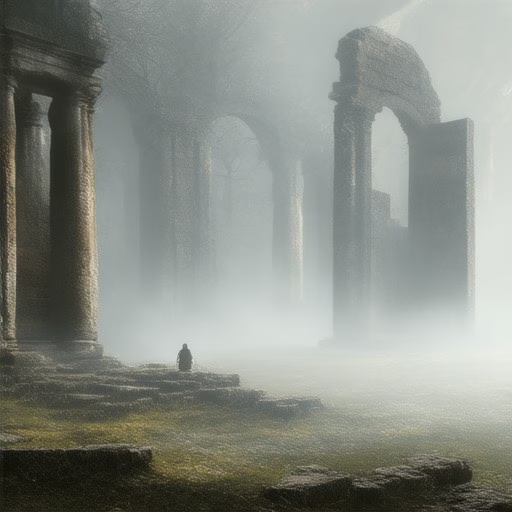Biblical historical sites remain a fascinating topic of curiosity for many, as people often wonder if the places described in the Bible actually exist today. While most of these iconic locations are not widely known, they hold significant historical and spiritual importance. From ancient ruins to sacred landscapes, the evidence left behind by these biblical sites offers a unique window into the past. By exploring these real-world locations, we can connect the ancient stories of the Bible to tangible historical facts, revealing hidden truths that challenge and inspire us. Whether you’re a history enthusiast, a believer, or simply curious, this journey through biblical historical sites promises to shed light on the blend of faith and factual evidence that shapes our understanding of the Bible.
Key Takeaways
– Historical Structures from Jesus’ Time: Several buildings from Jesus’ era still stand, including the Wailing Wall and the Church of the Holy Sepulchre, offering a tangible connection to biblical events.
– Archaeological Evidence: While no physical remains of Jesus have been found, indirect evidence like historical records and artifacts, such as the Shroud of Turin, provides insight into his life.
– Scholarly Debate: The absence of direct archaeological proof sparks discussions among historians and theologians, who rely on historical and textual evidence to affirm Jesus’ existence.
– Biblical Sites Preservation: These sites remain preserved due to their historical and religious significance, attracting pilgrims and scholars seeking to connect with ancient events.

Biblical Artifacts Found
Yes, numerous biblical artifacts have been discovered over the years, providing valuable insights into the historical context of the Bible. Here are some notable examples:
- The Tel Dan Stele (circa 9th century B.C.) is considered the oldest non-biblical reference to “the House of David,” offering clues about biblical figures.
- The Dead Sea Scrolls , discovered in 1947, include ancient texts like the Book of Isaiah, shedding light on the Bible’s origins and early versions.
- The Shapir Hoard uncovered in 2018 includes coins and pottery from the 8th century B.C., linking it to biblical trade routes.
- Fragments of the First Temple Period have been found, such as the Jehoash Tablet, which records repairs to the Temple in Jerusalem during King Jehoash’s reign.
- The Genesis Scroll , discovered near the Western Wall in Jerusalem, dates back to the 1st century A.D. and aligns with biblical accounts.
These discoveries continue to enhance our understanding of the Bible’s historical setting and provide archaeological validation of its narratives.
For more details on these artifacts and others, explore resources like Bible History Online and Ancient Origins .
Do the places in the Bible still exist?
Yes, many of the places mentioned in the Bible still exist today, though some are now ruins or archaeological sites. These locations hold historical significance and continue to inspire people around the world. Below is a list of notable biblical places that remain visible or are preserved:
- Jerusalem – One of the most famous biblical cities, Jerusalem is home to several key landmarks such as the Wailing Wall and the Dome of the Rock . These sites are part of the Temple Mount , which is considered sacred by Jews, Christians, and Muslims.
- Bethlehem – Known as the birthplace of Jesus Christ, Bethlehem is still a vibrant town in modern-day Israel. The Church of the Nativity marks the spot where Jesus is believed to have been born.
- Nazareth – Another significant biblical city, Nazareth is where Mary and Joseph lived before Jesus’ birth. The Synagogue of Nazareth is a notable landmark.
- Qumran – The site of the Dead Sea Scrolls discovery, Qumran is an archaeological ruin that dates back to the Second Temple Period. Excavations have revealed ancient scrolls and structures.
- Jericho – One of the oldest cities in the world, Jericho is mentioned in both the Old and New Testaments. The Jericho Wall is one of the few remaining walls from biblical times.
- Caesarea – Built by Herod the Great, Caesarea is a coastal city that served as the capital of Roman Judea. The Caesarea Aqueducts and Cruciform Pool are among its notable remnants.
- Megiddo – A strategic fortress city in the Valley of Jezreel, Megiddo is mentioned in the Bible as a key stronghold. Its massive stone gates are among the best-preserved examples from the ancient world.
- Nineveh – The ancient capital of Assyria, Nineveh is mentioned in the Book of Jonah. While much of the city lies in ruins, some structures like the Nineveh Walls still stand.
- Babylon – Known for the Tower of Babel and the Hanging Gardens, Babylon is an ancient city in Iraq. While much of the city has been destroyed, some ruins like the Amurru Gate can still be seen.
- Sodom and Gomorrah – These two cities, often referenced together, are said to have been destroyed for their wickedness. Their exact locations remain unknown, but some scholars believe they lie beneath the Dead Sea .
- Petra – Also known as the Rose City, Petra is a stunning ancient city carved into rock in Jordan. It was the capital of the Nabataean Kingdom and is famous for its spectacular architecture .
- The Red Sea – Mentioned in Exodus, the Red Sea is a vital body of water between Africa and the Middle East. Modern-day countries bordering the sea include Israel, Saudi Arabia, and Egypt.
These places are not only historical landmarks but also important destinations for pilgrims, historians, and tourists who wish to connect with the events and stories of the Bible. Exploring these sites provides a unique opportunity to walk where Jesus walked and understand the cultural and religious contexts of the Bible.

The Oldest Archaeological Evidence of the Bible
The field of biblical archaeology has uncovered numerous artifacts and inscriptions that provide direct connections to the events, people, and texts described in the Bible. Among the most significant discoveries are:
- Dead Sea Scrolls
Discovered in 1947 near Qumrān, Israel, these ancient scrolls include fragments of the Hebrew Bible, such as the Book of Isaiah and the Book of Deuteronomy. The scrolls date back to the 2nd century BCE and demonstrate that the biblical texts were already well-established during that time. - Book of Habakkuk
Fragments of this Old Testament book were found among the Dead Sea Scrolls. The discovery confirms the antiquity of the text, with some scholars dating the manuscript to the 2nd century BCE. - Lachish Letters
Found in 1938 in Lachish, Israel, these letters date back to the 8th century BCE and discuss events related to the fall of Jerusalem to the Babylonians in 586 BCE, as described in the Bible. - Telugu Texts
Discovered in the late 19th century in the Sinai Peninsula, these texts include legal and religious documents written in Aramaic and Hebrew. Some of the content mirrors sections of the Hebrew Bible, offering insights into ancient Israelite society. - Jehoash Tablet
Dated to the 9th century BCE, this stone tablet mentions King Jehoash of Judah and his repairs to the Temple of Jerusalem, aligning with accounts in the Second Book of Kings. - Moabite Stone
Unearthed in 1967 near Jericho, this stone inscription recounts the reign of King Mesha of Moab and his defeat of Israel in 609 BCE, a event referenced in the Bible’s account of Elisha’s miracles. - Ammonite Inscription
Found in 1996 near Amman, Jordan, this stone slab details a battle fought in 609 BCE between the Ammonites and Israelites, corroborating biblical accounts of the same period. - Siloam Tunnel
Excavated in 1880, this tunnel was built around 800 BCE to channel water to the City of David in Jerusalem. Its construction aligns with biblical descriptions of water systems in ancient Jerusalem.
These discoveries collectively support the historical authenticity of the Bible, providing tangible evidence of the events, cultures, and societies described in its pages.

Are Any Buildings from Jesus’ Time Still Standing?
During Jesus’ time, several structures were built that may still stand today. Among these, the most notable is the Enclosure of the Cave of the Patriarchs in Hebron, Israel. This structure dates back to the Roman period, around the 1st century BCE, and is believed to have been part of a larger complex during Jesus’ lifetime. While much of the original structure has been destroyed or modified over the centuries, portions of the enclosure remain intact, serving as a significant historical site.
Another structure from Jesus’ time that continues to stand is the Wailing Wall in Jerusalem. Although the wall itself is not as tall as it once was, parts of it are believed to date back to the time of Jesus. The Wailing Wall is a remnant of the ancient Temple walls and holds great religious significance for many people.
Beyond these, there are other remnants of ancient buildings in the Holy Land that trace back to Jesus’ time. For instance, the Church of the Holy Sepulchre in Jerusalem contains the Tomb of Christ, which is believed to date back to the 4th century CE, though its origins may go back to earlier structures. While not entirely original, these sites provide a connection to the events described in the Bible.
Archaeological discoveries continue to shed light on the remains of other buildings from Jesus’ era. Excavations near the Sea of Galilee have uncovered synagogues and houses that are thought to date back to the 1st century CE. These findings offer valuable insights into the daily lives and religious practices of people during Jesus’ time.
The survival of these buildings is remarkable, as many were constructed during a period of intense political and cultural change. Their preservation often depends on their historical and religious significance, as well as ongoing efforts by historians and archaeologists to protect and restore them.
For more information on these historic sites and their significance, you can explore our articles on biblical archaeology and the history of early Christianity .
Archaeological Evidence of Jesus
There is no definitive physical or archaeological evidence of Jesus Christ. While numerous historical and textual records support his existence, no remains or artifacts have been discovered that conclusively prove his historical presence.
Indirect Archaeological Evidence:
- Historical Records : Roman and Jewish historical texts, including works by Josephus and Tacitus, provide accounts of Jesus’ life and ministry, though these are indirect evidence.
- Textual Accounts : The New Testament, particularly the Gospels, describes Jesus’ activities, teachings, and miracles. These texts are foundational for understanding his life but are considered religious rather than archaeological evidence.
- Artifacts Related to Jesus : A few artifacts, such as the Shroud of Turin and the James ossuary, have been linked to Jesus but remain controversial and debated among scholars.
Debate Over Evidence:
The absence of physical remains has led to debates among historians and theologians. Secular scholars often emphasize the lack of concrete archaeological proof, while religious communities rely on historical and textual evidence, combined with theological belief, to affirm Jesus’ existence.
While no archaeological discovery has definitively confirmed Jesus’ physical existence, the overwhelming majority of historical and scholarly consensus supports his historical authenticity based on contemporary records and textual evidence.
For further reading, explore our articles on Christian Apologetics and Biblical Archaeology .

What Structures from the Bible Are Still Standing?
The Bible is filled with iconic stories and landmarks that have left a lasting impact on history. Many of these structures are still standing today, serving as powerful reminders of ancient events and their spiritual significance. Here are some notable examples:
- Western Wall (Jerusalem)
The Western Wall, also known as the Wailing Wall, is one of the most sacred sites in Judaism. Built during the time of King Herod the Great in the first century B.C., it stands as a remnant of the Second Temple. Millions of visitors each year come to touch the wall, which is considered the holiest site for Jewish prayer. - Church of the Holy Sepulchre (Jerusalem)
This church holds profound significance for Christianity, as it is believed to be the site of Jesus’ crucifixion and burial. The Church of the Holy Sepulchre is located within the Old City of Jerusalem, near the Western Wall. - Temple of Solomon (Jerusalem)
While the actual Temple was destroyed long ago, its foundation can still be seen today under the Western Wall. The Temple of Solomon was the first Temple built by King Solomon and took 13 years to complete. - Qumran Caves (Near Jericho)
These caves are famous for containing the Dead Sea Scrolls, which provide valuable insights into early Christian and Jewish texts. The scrolls were discovered in 1947 and are now preserved in museums worldwide. - Bethlehem Chapel (Bethlehem)
This chapel is said to be where Jesus was born. It is located in Bethlehem, a city southwest of Jerusalem. The structure dates back to the 15th century and remains a popular pilgrimage site. - Pool of Bethesda (Jerusalem)
Known from the New Testament as the place where Jesus healed the paralytic, this pool is still visible today near the Church of the Holy Sepulchre. It is fed by the Virgin Mary Spring. - Cenacle (Jerusalem)
The Cenacle, also called the Upper Room, is traditionally believed to be the location of the Last Supper. It is located in a small room above the Church of the Holy Sepulchre. - Tower of David (Jerusalem)
Although the actual tower was destroyed, its archaeological remnants can be seen near the Western Wall. The Tower of David is mentioned in the Bible as part of King David’s conquests.
These structures not only stand as historical landmarks but also hold deep spiritual meaning for millions of people around the world. They continue to inspire wonder and reflection, connecting the past with the present.




0 Comments